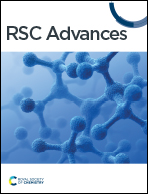
RSC Advances
Subject area
Nanoscience articles published in the last
6 months

Photocatalytic degradation of methyl blue dye with H2O2 sensing
ZnO nanoparticles impregnated polymer for the degradation of methyl blue dye with H2O2 sensing colorimetrically and fluorometrically.

RSC Adv., 2024,14, 14606-14615
https://doi.org/10.1039/D4RA01354A
A novel layered double hydroxide-based ternary nanocomposite for the effective photocatalytic degradation of rhodamine B
Photocatalytic degradation of organic pollutants is a green and effective route of wastewater treatment.

RSC Adv., 2024,14, 14523-14538
https://doi.org/10.1039/D4RA00685B
Advanced photocatalytic materials based degradation of micropollutants and their use in hydrogen production – a review
The future directions of photocatalytic degradation of micropollutants (pharmaceuticals, dyes, pesticides, etc.) and its role in green fuel production from wastewater are discussed with several examples of modern photocatalysts.

RSC Adv., 2024,14, 14392-14424
https://doi.org/10.1039/D4RA01307G
Use of deep eutectic solvents in environmentally-friendly dye-sensitized solar cells and their physicochemical properties: a brief review
A novel way to mitigate the greenhouse effect is to use dye-sensitized solar cells (DSSCs) to convert carbon dioxide from the air into useful products, such as hydrocarbons, which can also store energy from the sun, a plentiful, clean, and safe resource.

RSC Adv., 2024,14, 14480-14504
https://doi.org/10.1039/D4RA01610F
Unleashing the promise of emerging nanomaterials as a sustainable platform to mitigate antimicrobial resistance
The emergence and spread of antibiotic-resistant (AR) bacterial strains and biofilm-associated diseases have heightened concerns about exploring alternative bactericidal methods.

RSC Adv., 2024,14, 13862-13899
https://doi.org/10.1039/D3RA05816F
Ag/AgBr-oxygen enriched g-C3N4 for efficient photocatalytic degradation of trimethylamine
In this study, Ag/AgBr–O-gCN samples with ternary Z-type heterojunctions were prepared by in situ photoreduction using water as the reducing agent for generating Ag/AgBr active species and oxygen doping.

RSC Adv., 2024,14, 14068-14079
https://doi.org/10.1039/D4RA02395A
Bicomponent core/sheath melt-blown fibers for air filtration with ultra-low resistance
A one-step melt-blown spinning process has been proposed for the production of bicomponent core/sheath (BCS) crimped fibers, which can be applied to high-efficiency, low-resistance air filtration.

RSC Adv., 2024,14, 14100-14113
https://doi.org/10.1039/D4RA02174F
Colorimetric detection of Hg2+ based on the enhanced oxidase-mimic activity of CuO/Au@Cu3(BTC)2 triggered by Hg2+
A colorimetric method was designed for Hg2+ detection based on the enhanced oxidase-mimic activity of CuO/Au@Cu3(BTC)2.

RSC Adv., 2024,14, 13808-13816
https://doi.org/10.1039/D4RA01953A
Superhydrophobic foam combined with biomass-derived TENG based on upcycled coconut husk for efficient oil–water separation
Ocean ecological environments are seriously affected by oil spilling and plastic-debris, significantly reducing marine pollution via using biocomposite production from natural fiber reinforcement is a friendly way to deal with marine oil pollution.

RSC Adv., 2024,14, 13005-13015
https://doi.org/10.1039/D4RA01841A
Enhanced photocatalytic performance of ZnO under visible light by co-doping of Ta and C using hydrothermal method
C, Ta-co-doped ZnO nanoparticles (Eg = 2.88 eV), prepared by hydrothermal method, were used as a photocatalyst under visible light to remove organic contaminants in aquatic environments.

RSC Adv., 2024,14, 12954-12965
https://doi.org/10.1039/D4RA00579A
Application of cold-adapted microbial agents in soil contaminate remediation: biodegradation mechanisms, case studies, and safety assessments
Analyzed the microorganisms cold-adapted mechanism, and summarized the degradation pathway of nitro-aromatic compounds. Evaluated safety of microbial agents according to the existing application restoration cases under freeze-thaw cycles condition.

RSC Adv., 2024,14, 12720-12734
https://doi.org/10.1039/D4RA01510J
Synergistic effects of β-NaFeO2 ferrite nanoparticles for photocatalytic degradation, antibacterial, and antioxidant applications
Detailed antibacterial mechanism using by synthesized β-NaFeO2.

RSC Adv., 2024,14, 12513-12527
https://doi.org/10.1039/D4RA02430C
A self-powered photodetector through facile processing using polyethyleneimine/carbon quantum dots for highly sensitive UVC detection
Ultraviolet C (UVC) photodetectors have garnered considerable attention because the detection of UVC is critical for preventing skin damage in humans, monitoring environmental conditions, and detecting power aging in military applications.
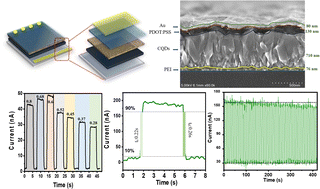
RSC Adv., 2024,14, 12360-12371
https://doi.org/10.1039/D3RA08538D
Reusable magnetic mixture of CuFe2O4–Fe2O3 and TiO2 for photocatalytic degradation of pesticides in water
Mixture of TiO2-P25 and magnetic CuFe2O4–Fe2O3 nanocomposites improves photocatalytic water treatment and enables easy catalyst recovery, effectively degrading pollutants like 2,4-D.

RSC Adv., 2024,14, 12337-12348
https://doi.org/10.1039/D4RA00094C
Investigation into the impact of CeO2 morphology regulation on the oxidation process of dichloromethane
Four distinct CeO2 catalysts featuring varied morphologies (nanorods, nanocubes, nanoparticles, and nano spindle-shaped) were synthesized through a hydrothermal process and subsequently employed in the oxidation of dichloromethane (DCM).

RSC Adv., 2024,14, 12265-12277
https://doi.org/10.1039/D4RA01326C
Rice husk valorisation by in situ grown MoS2 nanoflowers: a dual-action catalyst for pollutant dye remediation and microbial decontamination
In this study, we carried out valorization of rice husk through in situ growth of MoS2 nanoflowers for simultaneous pollutant dye remediation and microbial decontamination.
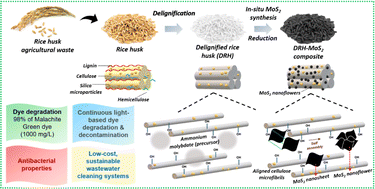
RSC Adv., 2024,14, 12192-12203
https://doi.org/10.1039/D4RA00862F
Synthesis and characterization of TiO2/hydrochar matrix composites for enhanced ammonia degradation
Development of a one-pot method for synthesizing TiO2/hydrochar matrix composites.

RSC Adv., 2024,14, 12131-12141
https://doi.org/10.1039/D4RA00671B
Advances in superhydrophobic material research: from preparation to electrified railway protection
Superhydrophobic coatings give a solution for the protection of electrical equipment and some corresponding preparation methods.

RSC Adv., 2024,14, 12204-12217
https://doi.org/10.1039/D3RA08180J
Skin emitted volatiles analysis for noninvasive diagnosis: the current advances in sample preparation techniques for biomedical application
Analytical technique for monitoring skin-emitted metabolites to diagnose diseases.

RSC Adv., 2024,14, 12009-12020
https://doi.org/10.1039/D4RA01579G
The engineering of defect-modified boron nitride ribbons: an effective adsorbent to rapid capture for tetracycline
BN-3 with 33% N defects has the biggest adsorption rate and the adsorption capacity of 302.15 mg g−1 for TC due to the decreased the absorption energy and the dominated chemisorption.
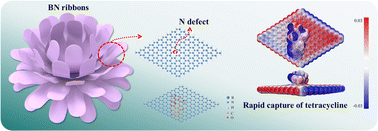
RSC Adv., 2024,14, 11932-11938
https://doi.org/10.1039/D4RA01941E
Corals-inspired magnetic absorbents for fast and efficient removal of microplastics in various water sources
Mesoporous Fe3O4 nanoparticles were coated with polymerized dopamine to mimic corals for adsorption of microplastics from different water sources.

RSC Adv., 2024,14, 11908-11913
https://doi.org/10.1039/D4RA02521K
Second phase Cu2O boosted photocatalytic activity of fluorine doped CuO nanoparticles
The photocatalytic activity of fluorine (F) doped CuO nanoparticles (NPs) prepared employing modified sol–gel process was investigated here in this study.

RSC Adv., 2024,14, 11677-11693
https://doi.org/10.1039/D3RA08790E
Comprehensive assessment of carbon-, biomaterial- and inorganic-based adsorbents for the removal of the most hazardous heavy metal ions from wastewater
This article is about recoverable adsorbents for the removal of metal-based water contaminants. It presents the role of the homogeneity and heterogeneity of adsorbents, kinetics of adsorption, and the mechanism of the sorption process.

RSC Adv., 2024,14, 11284-11310
https://doi.org/10.1039/D4RA00976B
Role of transition metals in coinage metal nanoclusters for the remediation of toxic dyes in aqueous systems
Coinage metal nanoclusters are doped with transition metals to obtain an efficient photocatalyst and adsorbent for the removal of toxic dyes.
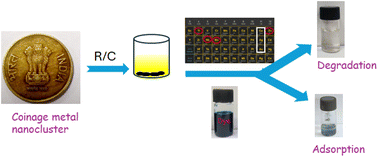
RSC Adv., 2024,14, 11411-11428
https://doi.org/10.1039/D4RA00931B
Assessing the efficacy of aluminum metal clusters Al13 and Al15 in mitigating NO2 and SO2 pollutants: a DFT investigation
The Al15 and Al13 exhibit excellent performance on NO2 and SO2 adsorption. The depiction explores critical points (3, −1) and the interatomic relationships between Al13 and NO2.

RSC Adv., 2024,14, 11217-11231
https://doi.org/10.1039/D4RA00708E
Browse by Subject
- All (336 articles)
- Atomic/elemental (14 articles)
- Bioanalytical (65 articles)
- Chemometrics (30 articles)
- Crystallography (164 articles)
- Electroanalytical (57 articles)
- Imaging/microscopy (32 articles)
- Mass spectrometry (22 articles)
- Medical diagnostics (77 articles)
- Microfluidics (17 articles)
- Nanoanalysis (20 articles)
- Separation science (27 articles)
- Spectroscopy (95 articles)
- All (272 articles)
- Bioinorganic chemistry (49 articles)
- Bioorganic chemistry (27 articles)
- Biotechnology (51 articles)
- Cellular chemistry (56 articles)
- Computational (84 articles)
- Drug delivery (78 articles)
- Drug discovery (181 articles)
- Imaging/diagnostics (15 articles)
- Molecular biology (6 articles)
- Nanotechnology (44 articles)
- Natural products (30 articles)
- Pharmacology (85 articles)
- Photobiology (15 articles)
- Polymorphism (pharma) (1 article)
- Structural biology (12 articles)
- Toxicology (3 articles)
- All (555 articles)
- Biomaterials (101 articles)
- Biopolymers (99 articles)
- Carbon materials (100 articles)
- Composites (247 articles)
- Electronic materials (96 articles)
- Encapsulation (1 article)
- Energy applications (84 articles)
- Films/membranes (82 articles)
- Gels & soft matter (36 articles)
- Inorganic materials (48 articles)
- Medical materials (66 articles)
- Nanomaterials (125 articles)
- Optical materials (51 articles)
- Organic materials (55 articles)
- Polymers (133 articles)
- All (349 articles)
- Assembly (11 articles)
- Biotechnology (30 articles)
- Carbon nanomaterials (80 articles)
- Imaging/microscopy (17 articles)
- Nanoanalysis (42 articles)
- Nanocatalysis (31 articles)
- Nanomaterials (217 articles)
- Nanomedicine (43 articles)
- Nanotoxicology (55 articles)
- Optical nanomaterials (33 articles)
- Synthesis (12 articles)
- All (173 articles)
- Bioorganic (17 articles)
- Catalysis (46 articles)
- Fine chemicals (26 articles)
- Natural products (23 articles)
- Physical organic (8 articles)
- Stereochemistry (11 articles)
- Supramolecular (3 articles)
- Sustainable synthesis (35 articles)
- Synthetic methodology (100 articles)
- Total synthesis (13 articles)
- All (320 articles)
- Biophysics (2 articles)
- Charge transfer (28 articles)
- Electrochemistry (13 articles)
- Energy research (18 articles)
- Imaging/microscopy (5 articles)
- Kinetics & dynamics (40 articles)
- Materials (104 articles)
- Mechanics (34 articles)
- Nanoscience (69 articles)
- Photoscience (26 articles)
- Quantum & theoretical (90 articles)
- Simulations (23 articles)
- Single molecules (40 articles)
- Soft matter (5 articles)
- Spectroscopy (7 articles)
- Surfaces & interfaces (71 articles)